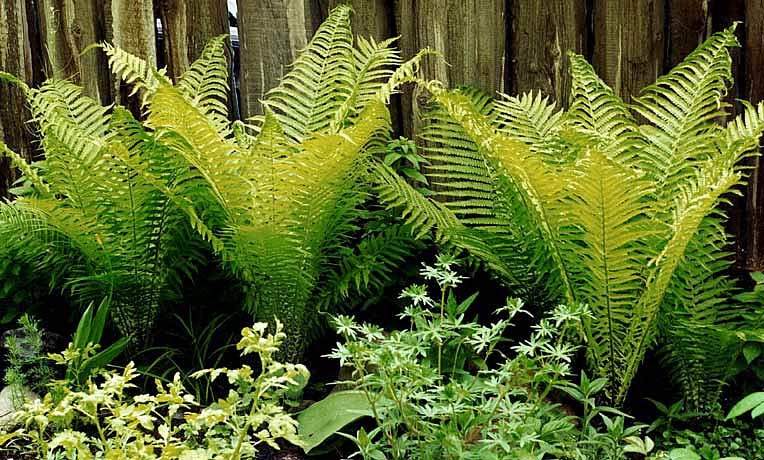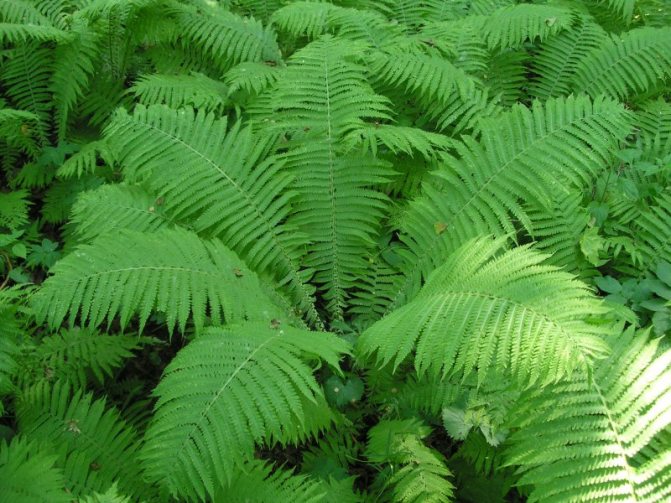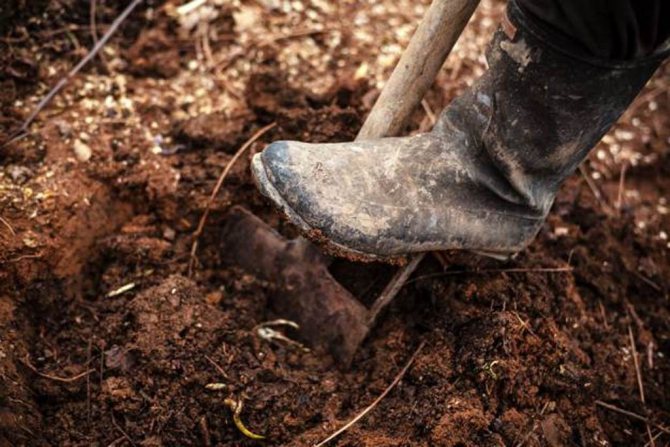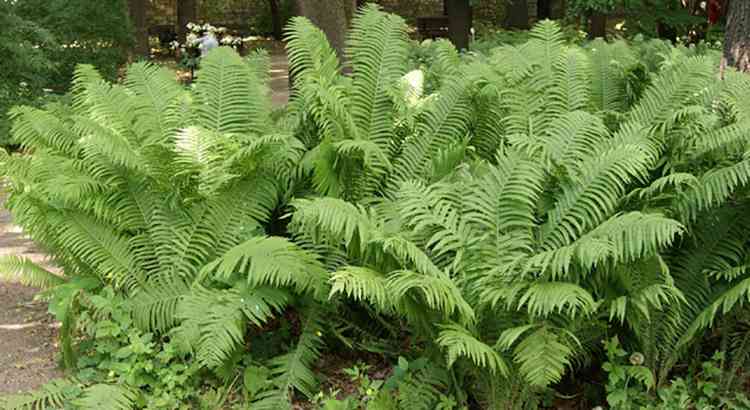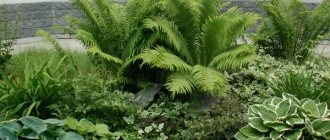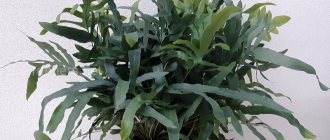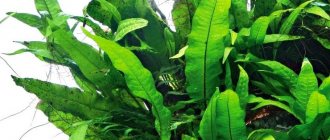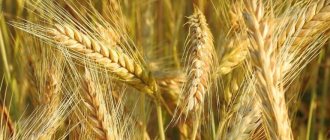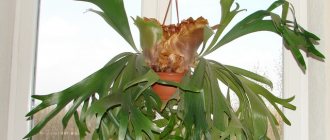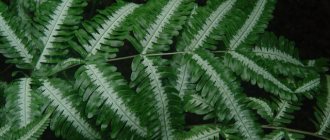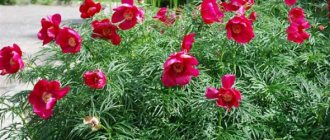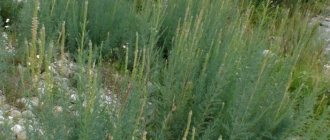The ostrich is a type of fern that can often be found in garden plots. The plant reproduces vegetatively due to scaly creeping shoots.
The fern has two types of leaves:
- sterile:
reach a length of one and a half to two meters, form a pinnate funnel; - spore-bearing:
two or three small leaves inside the funnel.
The name of the plant is due to the similarity of leaves with ostrich feathers. In fact, the plant has a lot of names, among others - German Ostrich.
Large foliage disappears in autumn, only spore-bearing shoots remain for wintering. In spring, their edges open, spores that have got into the soil begin to germinate.
The first leaves appear in May, as soon as stable warm weather sets in. They are folded inward first. Summer frosts can kill shoots, but the plant recovers quickly.
As it grows, the young foliage straightens out and forms a large funnel in the middle of summer. Sporiferous leaves appear in August. These brown shoots look very unusual and are often used as dried flowers for flower arrangements.
Views
There are two varieties of the Ostrich:
- ordinary;
- Oriental.
The first type is the most common.
The plant grows quickly, tolerates frost well and requires special care. Branches are wide, feathery, light green in color. In another way, this variety is called "varifolia", sometimes because of the black color of the trunk and the dimorphism of the foliage - "black fern".
Oriental ostrich
has large branches collected in bunches. It reaches a height of one and a half meters. The leaf plates are pinnate, the feathers are curled and narrow. The petioles are covered with a brown film.
These species differ in the number of first-order leaves, of which there are fewer in the eastern, but they are larger in size.
The eastern ostrich requires more careful care, in addition to regular watering, it needs protection from the wind.
Photo
For more photos of the Ostrich fern, see below:

Read more about common fern species here.
How it differs from other garden ferns
The ostrich outwardly resembles ferns-ferns or kochedyzhniki. But it is distinguished by a more powerful "crown": in favorable conditions, it can grow up to 1.5-2 m in height.
It is distinguished from other ferns by the shape of the bush. Its branches are arranged in a circle at the top of the bulbous rhizome. The shoots of this variety grow at the same time, so in the summer, the shrub looks like a vase with an empty middle.
The main difference between the Ostrich and the rest of the species is that by the end of summer it grows sporos that look like ostrich feathers. They appear in the center of the funnel and rarely reach 50-60 cm. Sporosi have twisted lobules resembling "sausages".
Common ostrich
Oriental ostrich
Shieldworm
Beneficial features
Ferns are considered champions for their ability to accumulate silicon, and the ostrich is no exception.Silicon is involved in the assimilation of many mineral salts and vitamins, prevents osteoporosis, stimulates immunity, improves the condition of the skin and nails, strengthens connective tissues, cartilage, tendons and blood vessels.
Once in the body, it "sticks" to its molecules the cells of microorganisms, bacteria, influenza, hepatitis, candidiasis and neutralizes them. Therefore, a sufficient amount of silicon in the body is the key to preventing stroke and heart attack, diabetes mellitus, cancer and many other diseases. The ostrich possesses effect:
- astringent;
- antitussive;


- antispasmodic;
- pain relievers;
- sedative;
- anticonvulsant;
- antiepileptic;


- antihelminthic;
- anti-inflammatory;
- antiseptic.
Care
Both types of Ostrich tolerate temperatures up to -10 C o. Too high a temperature (over 25 C o) is unacceptable - the plant will begin to wither and dry out. Like other ferns, the Ostrich does not like drought. Leaves should be sprayed in dry weather, the soil should remain moist at all times.
The plant can be fed with mineral or organic fertilizers. This is not a prerequisite for leaving.
Ostrich is transplanted in the spring. For this purpose, a young bush is dug up. You can plan a transplant at the end of summer - for this, a part of the mother's rhizome with a bud is used.
Pruning is not applied to ferns. However, once every three years, the plant is thinned out, as it grows strongly. For this reason, it is better not to experiment with group plantings.
Plant care, fertilization and feeding
The ostrich is a strong and viable plant. Therefore, growing it is a pleasure. First of all, care and protection are needed for neighboring garden, vegetable or ornamental crops, if any. Gardeners use artificial barriers. For example, a wide plastic tape dug around the perimeter of the planned area. For planting in a flower bed, you can use a spacious bucket without a bottom, along with which the fern is buried.
Attention! Growing an ostrich in one place is possible without problems for 6-7 years. The plant can then be transplanted. The procedure is performed in the spring. It is not necessary to extract the entire plant - it is enough to take only a part of the rhizome with a bud. In a new location, the plant needs abundant watering to adapt.
Other aspects of caring for the common ostrich outdoors:
- Control humidity. During a drought, the plant should be sprayed.
- For the winter, the ostrich should be sheltered only if prolonged frosts of -10 ° C or more are expected in your region.
- The fern does not tolerate heat well from +25 ° C.
- Watering is moderate. If there is no rain for a long time, increase the water dose
Interesting: Eremurus
This fern does not need fertilization. But still, flower growers sometimes use them. Any organic or mineral mixture will do. Apply fertilizers about 1 time per month during the first year of the plant's life, at your discretion.
Application in landscape design
The common ostrich has found wide application in landscape design. This plant is not intended for home cultivation and is planted only in summer cottages, parks, gardens, etc.
Ferns look good in group plantings with other plants, they are in perfect harmony with boulders and. The bushes are planted in the darkened corners of the garden, on the northern slopes. The ostrich is used for decoration and front gardens.
Any fern, including Ostrich, are irreplaceable when peat soils are oversaturated with moisture.
The common ostrich looks great with large and bushy flowers:
- irises;
Ostrich and Rhododendron (Rhododendron Galathea)
In too shady areas, the fern successfully coexists with the daylily,.
When including ferns in flower beds, you need to take into account that the plant can creep and suppress other specimens, so this should be done carefully.
Ferns are often planted together with spring bulbous flowers, tulips, daffodils: the emerald foliage of the Ostrich well hides the fading bulbous ones.
It is better not to plant a fern along too narrow paths, as while walking you can injure the delicate and fragile foliage. On the garden plot, it is better to give the Ostrich a place between the house and the fence, where they do not go very often, but the view from the window matters. The ostrich looks great between pines, and large apple trees
.
The ostrich and other types of ferns are actively used in the design of winter bouquets. Sporiferous plants retain their shape for a long time and are used as a dried-flowering material for various floristic compositions.
Diseases and pests of the ostrich
The common ostrich can take a liking to the Tarfin marsupial mushroom. This parasitic organism causes leaf spot. In addition, it sometimes touches adjacent ornamental and fruit trees. The affected tissue must be cut off and burned, the plant must be sprayed with a fungicide. As a preventive measure, spring treatment of plantings with copper sulfate or Bordeaux liquid helps.
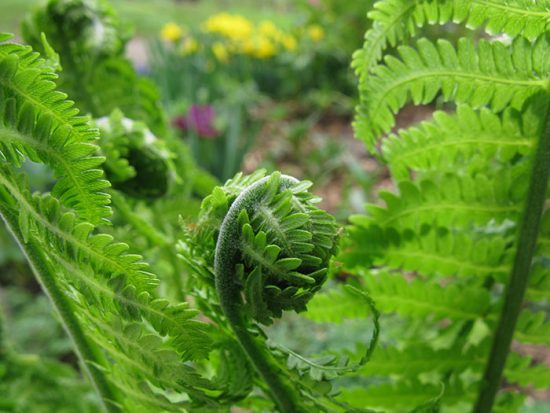

Review on video
About the ostrich in the garden - in the blog Harvest beds.
A favorite of gardeners and a real find for those who decided to improve their health. It's all about him. Fern ostrich. A unique plant of its kind. It has been known since ancient times to doctors for its healing properties. Unpretentious in care, survives even at minus 10 degrees Celsius.
The plant has a wide geography of distribution. It grows in most of Russia and in neighboring countries, as well as in the East. There, the plant is eaten, and some ready-made dishes are decorated with it.
Probably everyone can distinguish this representative of the flora from any other plant. It has long, thin leaves that, if connected to the imagination, resemble an ostrich feather. The length of the leaves can reach two meters, but specimens of one meter in height are most often found.
As for the species, there are two of them. Common and eastern are common on the territory of Russia. Each of them has its own characteristics and is easily distinguishable from the other.
Ordinary
This species is considered the most famous. It grows in home gardens and forests. Not too picky about the soil. Easily tolerates light frosts and heavy rainfall.
The leaves of this representative of the flora are called fronds. In the “ordinary” species, they are wide enough, light green, sometimes with a black stem, which is easily noticeable. That is why this species is also called black fern. The plant is also called velamkuch. In the literature there is also the name varifolia.
A characteristic feature that distinguishes the common ostrich is its wide and thick fronds. There are no other such in nature. This species can reach a height of two meters.
Ordinary
fern is the most valuable plant that is strictly protected. It is included in the Red Book of the Russian Federation. For destruction, a large fine is threatened.
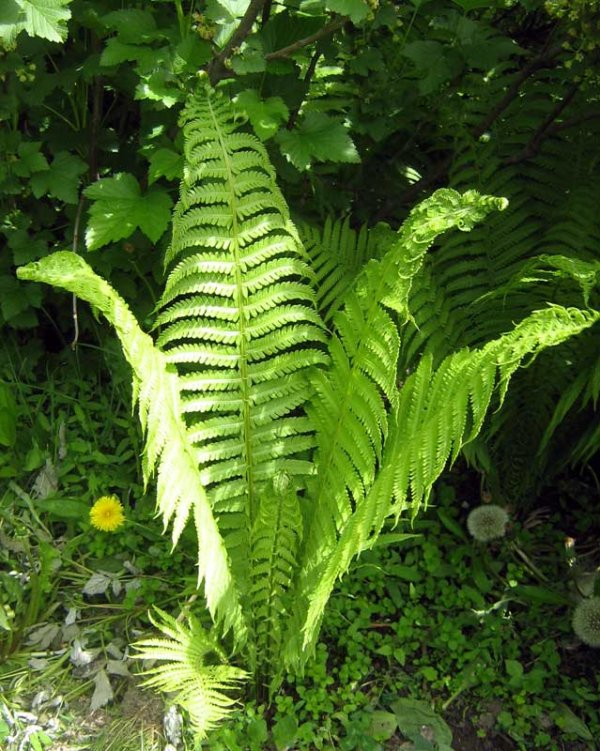

Oriental
This species is found in nature much less often than usual. His fronds are wide, but not too frequent, they also look like an ostrich feather. They seem to twist in the direction of growth.
Eastern fern does not tolerate frost, it is hard to tolerate heat and abundant moisture. It is extremely difficult to breed it, so it rarely appears on personal plots.
Planting and caring for the ostrich fern
Planting an ostrich fern and the subsequent care of the plant is not difficult. Subject to simple rules, the plant will feel great in almost any area and delight with fluffy green leaves.
Landing dates
Planting shoots with a vegetative reproduction method is carried out either in the first spring months before the leaves appear, or at the end of summer, when sporulation occurs.
If the ostrich fern is propagated from spores, then the matured plants are transferred to open ground in the spring, when the weather is warm.
Site selection and soil preparation
Both a shaded area and a well-lit area are suitable for growing ferns. It should be borne in mind that with a large amount of sunlight, one should not count on strong growth of shoots (their height in this case will not exceed 1 m) and rich color of leaves. The most juicy color is acquired by the leaves of the ostrich growing in shaded areas with high humidity.
When choosing a site, you need to pay attention to the fact that the root system of the plant grows very quickly and after a year it may be at a distance of several meters from the main bush.
As for the soil, sandy dry soil is not the best option. This soil will have to be watered frequently to create comfortable conditions for plant growth. Otherwise, the fern has no requirements for the composition of the soil. It can fully develop on both fertile and infertile lands, as well as on soils with any acidity.
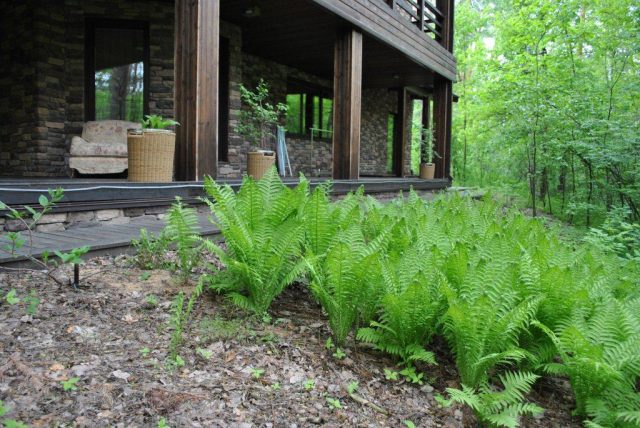

How to plant correctly
The rules for planting an ostrich depend on which method is chosen for breeding. With the vegetative method, a part of the rhizome with a length of 20-30 cm is taken. At the same time, there should be at least 2 buds on the process. It is planted to a depth of about 5 cm at a distance of at least 50 cm from other ferns.
This is interesting: The best varieties of princes - planting a flower in open ground
Raising an ostrich from spores is a laborious but more efficient process. Spores are collected in August and planted in a disinfected peat mixture. In this case, the collected spores do not have to be planted immediately, they can be stored for several years. The container with the planted spores is covered with a strong transparent lid and left for a while, remembering to regularly air and water.
After a few weeks, when the spores have germinated, the lid can be removed. The grown fern is dived and planted in separate containers. At home, seedlings are grown for at least 2 years and only then are they taken out to the site.
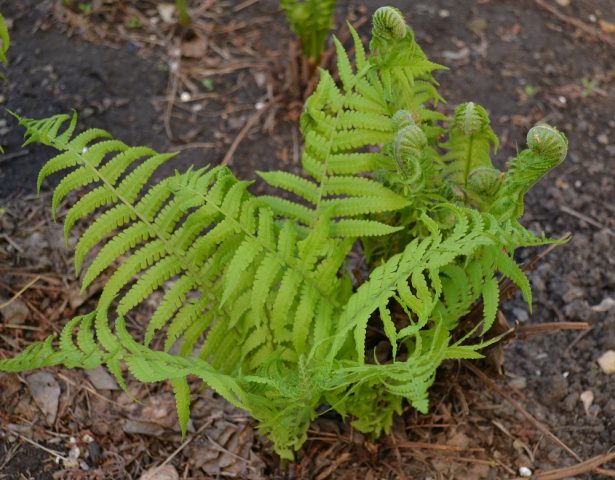

It is better to plant a fern in groups of 5-6 pieces at a distance of at least 40-80 cm from each other. For planting, it is recommended to use a scheme similar to the natural growth conditions of an ostrich, triangles. Such a planting will ensure the subsequent independent vegetative reproduction of the fern.
Breeding
A fern can be a decoration of any site, it is also useful for providing urgent medical care. In breeding, it is the common ostrich that is simple.
He needs to allocate a place where direct sunlight does not fall. Before planting, the soil must be well moistened, otherwise the plant will not take root.
This type reproduces by spores and leaves. It is possible to grow an ostrich from seeds, but it is too difficult and time-consuming.
The plant is very fond of abundant watering. He needs them to settle down in a new place. Therefore, experienced gardeners in the first couple of weeks after planting a fern are advised to water the plant with water as often as possible, up to 3 times a day. No fertilization required. Such is the simple care.
Disputes
- This type of reproduction is very similar to the seed method, but more complex and effective.
- Collect spores just after summer, early fall.
- Sow them in a container with litter peat that has been disinfected beforehand.
- Cover with glass, and, as advised above, water abundantly up to 3 times a day with water.
- After 30-40 days, the first shoots will begin to hatch, transplant them into the prepared mixture (sand, peat crumbs, heather soil), and let them grow there for several years, then you can transplant them to the area you need.
Leaves
The plant has processes under the ground with buds, and they should be used for this type of reproduction in early spring or, if not in time, in August. The shoots should be planted at a distance of 50 cm from each other in a mixture of sand, peat chips and heather soil for several years. Then you can transplant anywhere.
Common ostrich: planting a plant
For planting in the open field, seedlings 2-3 years old are suitable. Find a shaded place for them on the site. The ostrich will grow in the sun, but it will not be large. Florists advise planting a plant in groups of 5-7 pieces.
The landing pattern is as close to natural as possible. For example, irregular triangles. At the same time, observe a distance of 0.3-1 m. The advantage of this method is that in a couple of years the fern will independently increase its number by vegetative means. You just have to manage to remove unnecessary plants, and form a green decoration of the site from all the rest.
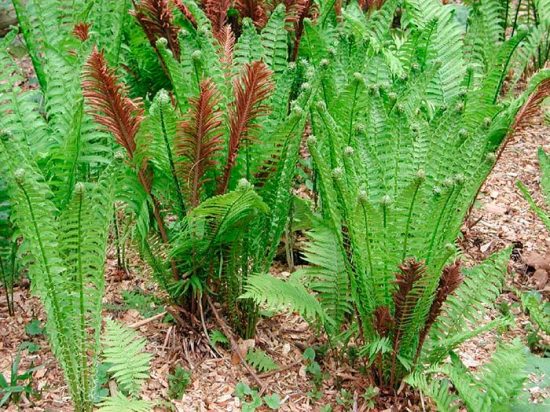

How to care
There are a few more simple care rules that will help you grow a beautiful and healthy representative of the flora without difficulty and at special costs.
- Minimum sunlight. His plant is not afraid, but in the sun it is not particularly active. Therefore, those who intend to grow a large fern are recommended to breed it in fairly dark places.
- Monitor the air temperature. The plant is not afraid of frosts down to minus 10 degrees Celsius. Does not like overheating above +25 degrees.
- Watch the humidity. The ostrich prefers abundant watering, does not cope well with drought. Therefore, experienced gardeners recommend watering more often or at least spraying the plant in the heat.
- Do not fertilize. A representative of the flora does not need them. This is a waste of money and energy. The plant does not require additional stimulation.
- Be careful about your transplant. The ostrich grows quickly, so it needs to be planted and transplanted. This is another requirement for plant care. It is best to do this in the spring, when the fern "comes out" of hibernation.
This plant is not susceptible to disease and does not attract pests, which is very popular among gardeners.
Contraindications
- pregnancy and breastfeeding;
- age up to 14 years;
- serious kidney, heart disease;
- stomach ulcer;
- allergy to alkaloids;
- intolerance to the components.
Raw shoots and fern spores may accumulate toxins... To avoid poisoning and not to confuse the black sarana with other poisonous species of fern, treatment should be started under observation experienced herbalist.
Fern medicine
The ostrich fern, as the ostrich fern is also called, was known to ancient healers. The simplest tinctures on alcohol and water were made from it. The leaves (fronds) were covered with liquid and left in a dark place for a week.
Common and oriental ostrich are famous for their healing properties:
- wound healing. Leaves are recommended to be applied to open cuts or scratches;
- vasoconstrictor. Fern tincture is taken one tablespoon twice a day;
- antispasmodic. Fern tincture is taken once to relieve spasm.
Varieties and description
All species of this fern are very similar and have large leaves that resemble ostrich feathers. There are only two types of ostrich - common and oriental.
Fern ostrich common
A very popular type of fern, which has good frost resistance and is completely unpretentious. It grows fast enough. It tolerates winter well and grows in absolutely any soil. The most important thing is a sufficient amount of moisture. This species will grow both under the scorching sun and in the shade, if it is provided with intensive and regular watering.
This look looks very good on any summer cottage.... They decorate the paths, ponds or garden compositions.The common ostrich behaves very aggressively with neighbors in the flowerbed, so it is better to plant it separately or make sure that it does not grow much, since the roots of this plant grow quickly enough.
Oriental ostrich
Grows up to two meters. This species, unlike the ordinary one, is quite whimsical. He is afraid of drafts, strong winds and needs constant watering. Does not tolerate frost very well.
Distributed in Sakhalin, China and northeastern Russia.
Summary
Ostrich fern, or ostrich perch, is a plant for planting in a summer cottage. It does not require special attention, it is unpretentious in care and is hardy. Today the plant is used as a medicine. The beneficial properties are scientifically proven.
It is important to remember that the plant is poisonous to animals. Therefore, it is unsafe to plant an ostrich bird in places where livestock are run.
Matteuccia, Ostrich. The height of the strict funnel-shaped fern bush can reach a height of 150 cm.
Fronds are pale green, feathery, with linear leaves, reminiscent of an ostrich feather, grow back with the onset of stable heat. Spore fronds appear in August. They are brownish, feathery, with narrow feathers and edges wrapped up to the middle of the vein. Most widely used
Etymology
Its name is determined by the shape of the leaf, reminiscent of ostrich feathers.
Types and varieties of ostrich fern
The genus unites 4 species, whose homeland is the moist forests of the temperate zone of the Northern Hemisphere. In ornamental gardening, the most widely used common ostrich (Matteuccia struthiopteris).
Common ostrich (Matteuccia struthiopteris)
In nature, it grows in the forest zone of Eurasia, along damp forests, the outskirts of swamps, river banks. Long-rooted fern. The annual growth of rhizomes is up to 25 cm. Under suitable conditions it sometimes reaches 200 cm in height. This is a large plant (up to 150 cm) with leaves collected by a funnel, with a lack of moisture, 40-60 cm high. Forms loose thickets. Fronds are delicate, light emerald, broadly lanceolate, feathery, collected in a goblet funnel. They appear when stable heat is established (late April-early May). At first, these are fluffy dense shoots wrapped inward (like a cam), which gradually grow back and at the same time straighten (at this moment the fern is unusually decorative). By the end of May, the bowl of leaves is fully formed, and in August, brown, dense, leathery, shoots - feathery sporophylls, up to 60 cm long, appear in its center.
The leaves persist until the end of August and then turn yellow.
The ostrich is widespread in the temperate zone of the northern hemisphere in swamps and along the shady banks of rivers and streams, in floodplain forests. Young leaves of this fern in some countries are eaten as vegetables.
Ostrich care
Moist peaty soils, shade and partial shade are ideal conditions for this fern, providing vigorous plant growth and its greatest decorative effect. The plant is cold-resistant, not demanding, grows well in different conditions - in shaded and sunny areas, on poor and rich soils, but always on damp and moist.
Since the ostrich grows rapidly (up to 25 cm per year), it is important to thin out the plantings every 3-4 years.
Ostrich breeding
Propagated by segments of rhizomes with a bud of renewal, tolerates transplanting well, especially in spring (before the leaves open) and at the end of summer.
The ostrich is one of the most decorative, culture-resistant ferns. It can be widely used in landscaping for group plantings, especially near water and on waterlogged peaty soils.
Looks great as a separate spot on the lawn. The main thing is not to forget about good soil moisture and shade, as well as their ability to creep and suppress other plants, and then the fern will delight for many years.
Folk legend says that the fern blooms only once a year - on the night of Ivan Kupala. Those who manage to find a flower will be more than rewarded for their efforts: the plant will indicate the place where the treasures are buried. Thanks to this belief, ferns have long been considered mysterious and amazing plants.
The common ostrich is a very large fern that grows up to 1.5-2 m under suitable conditions. It has a thick vertical rhizome and delicate light emerald lanceolate leaves. For their resemblance to ostrich feathers, this fern got its name. It grows almost everywhere in the temperate regions of the Northern Hemisphere, including in and on. However, it is rare in Central Europe, therefore it is included in the Red Data Books of a number of regions.
Ostrich: combination with other plants
A group planting of an ostrich is already a beautiful combination in itself. When choosing other companions, keep in mind that the fern grows late. In the design of the plots, the masking properties of the ostrich are used to hide early withering crops: crocuses, woodlands, etc.
A fern in the company with moss, snags and stumps will create a forest composition on the site. This atmospheric installation for photography will be complemented by a saxifrage, primrose, moneta loosestrife or creeping tenacious. The combination of an ostrich with a swimsuit, daylilies, decorative varieties of cereals and irises looks interesting.
MAGIC FUEL
Going in search of a wonderful fern flower, it was necessary to stock up on amulets that protect the owner from evil spirits. Most often, young people carried with them a bunch of bitter wormwood, which has a pungent odor and bitter taste. In order to deceive the forest spirits, who also want to get the coveted plant, the daredevils entered the forest with their backs forward, trying to confuse the evil spirits. According to the legends, the bright red flower bloomed on the fern exactly at midnight and only for a few minutes. Its owner not only revealed the secrets of treasures and treasures, but also the language of birds and animals became clear.
This belief is associated with the peculiarities of fern reproduction. These plants never bloom as they reproduce by spores. Our ancestors did not know about this. They assumed that flowers on ferns appear very rarely, and therefore, undoubtedly, have miraculous properties.
Diseases and pests
Another undoubted plus of the ostrich fern is its high resistance to various diseases, as well as to the effects of insect pests.
The only danger is the thickening of the plantings in combination with high humidity. Under such conditions, fungal infection is possible. It appears as dark spots on the leaves. If found, it is necessary to remove and destroy the affected shoots, and spray the remaining plants with a fungicide.
Important! To prevent the appearance of fungus, it is recommended to treat plantings with copper sulfate in the spring.
HELLO FROM PALEOZO
These plants appeared on our planet more than 400 million years ago. At that time, large tree ferns dominated the Earth. Most of them have disappeared, and now herbaceous forms prevail among 10,500 species of these plants.
The feathery leaves of the common ostrich, like other ferns, are called fronds or flat-branches. They resemble shoots rather than leaves. Vayi have apical growth and can reach impressive sizes. They appeared in ferns as a result of flattening of the branches of ancient ancestors. This increased the surface area and increased the efficiency of photosynthesis.
Common ostrich: plant propagation
Like other ferns, the ostrich is strong in independent reproduction by spores. Collected spore bolls are an effective and troublesome method. The best time to collect spores is late summer or early autumn. They are suitable both for storage in a dry place and for immediate planting for propagation.In any case, peat litter is suitable for seedling. Disinfect it first.
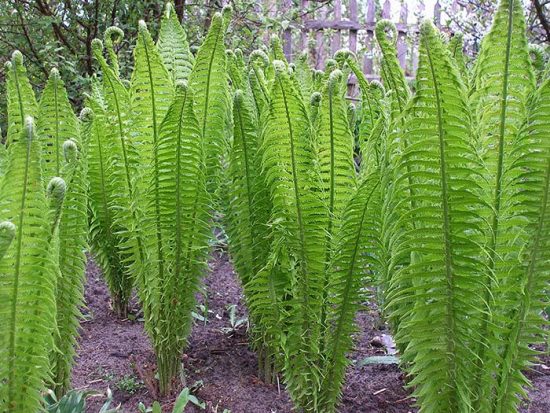

Deepen the spores into the substrate, then water and cover with glass or plastic. Of the care measures, the crop only needs periodic moistening. The sprouts will appear in 25-40 days. Transplant them directly into a fern-friendly soil available at the store. Further care and cultivation of the plant consists in maintaining a high level of humidity, if necessary, in transplanting into a more spacious pot. In this mode, young plants will live for several years before planting in open ground.
An alternative to spores is vegetative propagation by root shoots. To do this, find them in the top layer of the soil. Schedule work in early spring or August. The process should have 2-3 buds:
- Slice the shoots about 10 cm long.
- Plant them in open ground at intervals of at least 50 cm.
Attention! At the first stage of development, fertilizers are not needed for ostriches planted in any way.
THE MYSTERY OF REPRODUCTION
The fronds of the common ostrich are of two types. Some are vegetative, colored bright green and have the ability to photosynthesize. Vegetative leaves, also called trophophylls, form a kind of funnel. In its middle there are fronds, on which spores - sporophylls - ripen. Initially, these leaves are light green in color, but turn dark brown with age.
The edges of the sporophylls appearing at the end of summer are curtailed. Thanks to this, sori - organs containing maturing spores - are protected from adverse conditions. In spring, with the onset of warm days, the edges of the leaves unwind. The spores spill out onto the ground, and each spores give birth to a tiny, green, overgrown plate. On its lower side, pressed to the ground, the organs of sexual reproduction are formed: gametangia, which produce sperm, and eggs. Sperm cells reach the eggs through the water, and some time after fertilization, a young fern begins to develop. The common ostrich can also reproduce vegetatively, using the processes of the rhizome.
How fern reproduces ostrich feather
Ferns are among the oldest plants that arose even before the appearance of bees. It is with this that the lack of flowers in this plant is connected - it does not need pollination and seed development.
There are 2 ways to breed a fern:
- Vegetative - by separating part of the root with sprouts and buds.
- With the help of a dispute. Disputes develop on fronds located in the center of the rosette. They are collected at the end of summer and planted in a small closed container, regularly watering and airing. After 1-2 years, when the sprouts get stronger, they can be planted directly on the site.
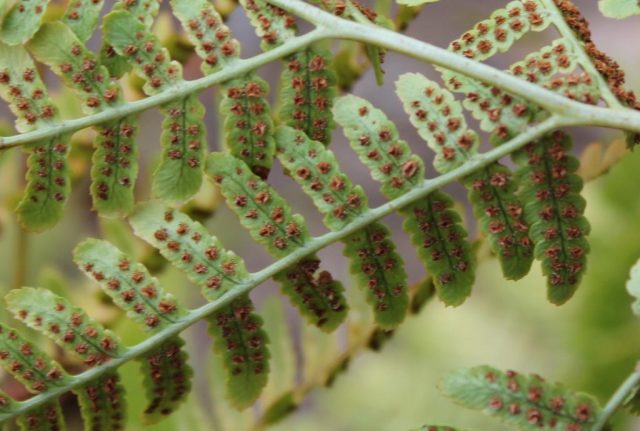

UNHEADY, TASTY AND BEAUTIFUL
Many gardeners willingly grow this fern. It is quite unpretentious: the ostrich grows equally well both in sunny and shaded places. The fern tolerates cold weather and is practically unaffected by insect pests. The ostrich is the most demanding for watering: for good growth, it is important to timely moisten the soil.
It is interesting that in many countries this plant is eaten. Young fronds, just emerging from the ground, are considered a special delicacy. They are in the form of a spiral, which soon unwinds. It is the young "snails" that the Indians and residents love to feast on. Vayi is consumed both fresh and boiled. Residents use the common ostrich in agriculture as feed for livestock.
This fern is also very popular in folk medicine. Spores are used as a powder to combat complications from burns, wounds, frostbite. It is believed that a decoction of rhizomes helps get rid of worms, and frond compresses reduce pain.
It is interesting that in the 18th century the mystery of the reproduction of ferns, horsetails, and lyre was not yet solved, therefore, Karl Linnaeus united these and some other plants that do not have flowers into the "secret marriage" group.
The benefits of the ostrich
Fern in the form of ostrich feathers is used for medicinal purposes. They can treat some diseases:
- A decoction of the roots will help get rid of worms.
- Compresses from ostrich leaves are used for bone pain.
- The decoction from the roots helps with menstrual pain, as well as other female diseases.
- Tincture from the roots will help get rid of insomnia, stomach pains and has a calming effect on the nervous system.
- Spore tincture will help relieve the inflammatory process.
- Dried spores help with burns and minor wounds.
A BRIEF DESCRIPTION OF
Kingdom: plants. Division: fern-like. Class: fern. Order: millipede. Family: on-glue. Genus: ostrich. Species: common ostrich. Latin name: Matteuccia struthiopteris.
Size: height can reach 1.5 m. Life form: herbaceous perennial.
6 904
The ostrich fern is one of the most spectacular perennial garden plant species. It is planted in shaded corners of the garden, under trees and near fences - everywhere it serves as a decoration of the site. Emerald green leaves, unpretentiousness and high winter hardiness have made this fern a favorite of many gardeners.
Ostrich (Matteuccia) is a fern of the Onoklei family. His homeland is the temperate zone of Eurasia. It occurs naturally in the damp forests of the European part of Russia, in the Caucasus, in the shady floodplains of the rivers of Siberia and in the Far East.
Cultivated in gardens Common ostrich (Matteuccia struthiopteris). Fern leaves (called fronds) are of two types:
- sterile - emerald green, feathery, up to 1.5 m long, forming a beautiful funnel;
- spore-bearing - small, brown, of unusual shape, growing inside the funnel.
The large sterile leaves of the ostrich are tightly folded at the beginning of their growth, then gradually unfold, forming a large funnel and reaching their peak in June. In summer, they protect spore-bearing leaves from bad weather, which appear later, and die off in autumn. Spore-bearing frond hibernates on bushes, expanding their edges in spring and scattering spores.
The ostrich reproduces rapidly vegetatively, forming whole thickets under suitable conditions. He has a large rhizome, from which underground creeping shoots depart. The fern suppresses other plants planted nearby.
Description
The ostrich differs from other types of fern precisely in the shape of the bush. The leaves are arranged in a circle from the root and grow back at the same time, which forms such a beautiful funnel-shaped shape.
A feature of this species is the rapid growth of spores, the dispersal of which occurs in the spring. As the disputes dissipate, new ones are formed.
The ostrich is actively used by florists as an addition to bouquets. These leaves can retain their beauty for several years.
In the wild, the fern is found in mixed wet forests. Very common in Russia and the Far East... It can often be found near water bodies..
Growing up from spores
Ferns are the oldest plants and they appeared much earlier than bees. This fact explains the lack of flowering and the formation of spores - this is how nature took care of reproduction. Along with spores, fern can be diluted by dividing the rhizome.
Collection of planting material, sowing
You can determine the readiness of the sporangia by the color of the frond - if it becomes dark, almost black, then it is cut off and placed in a paper bag, in a newspaper. After a short time, it will dry out, and the spores that look like powder will spill out. It is necessary to separate the spore powder from foreign debris so that it does not interfere with planting and does not fall into the ground. The powder is stored for a long time (5-6 years), but over time, germination decreases.
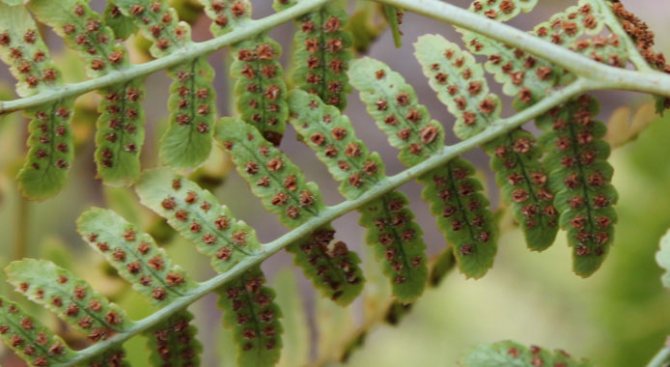

Germination takes place in 1-2 weeks, it takes about two months for the formation of overgrowths, and the same amount for the formation of the root system. Taking into account these terms, the recommended planting time is autumn, the beginning of winter.
Preparation of containers, soil
Moisture is necessary for germination, so it is better to choose containers with a lid. You can take ordinary food containers (0.5 l) - the new ones do not require disinfection, the old ones must be rinsed with a disinfectant.
The potting mix should be light and hold water well. A mixture of peat, sand, leafy earth (2: 1: 1), sphagnum (grind before use), a universal mixture for indoor plants is suitable. To avoid the appearance of mold, the soil mixture must be steamed, spilled with boiling water or a manganese solution.
Sowing and care
Clean containers are covered with soil mixture 1/2 of the height, spilled with warm boiled water so that the earth is saturated, and the water level is below its surface. To evenly distribute small spores, take a stick, a pencil, dipped in spore powder and lightly touch the soil surface, do not sprinkle anything on top. Particles of frond should not fall into the ground, because they will start to rot. Close the lid, put the container in a bright, sunny place.
Depending on the shelf life of the spore powder, seedlings, they are called overgrowths, can appear in a week, in a month or more. The tiny outgrowth at first looks like a green ear with thin roots, but it still cannot be called a fern. Male cells (sperm) from the reproductive organs located on the underside of the outgrowth, with moisture, enter the female cells on neighboring seedlings, fertilization occurs, after which the fern begins to grow. Those overgrowths that have not fertilized die.
Approximately 7-30 days after the emergence of the overgrowth, the shoot and roots begin to develop. If during this time they did not appear, then there is a possibility that they will not appear at all.
Care consists in airing to remove condensation, in maintaining moisture and cleanliness of the soil - spray with boiled water, to prevent the appearance of mold. If it, nevertheless, appeared, or the overgrowths began to turn brown, then it is imperative to treat it with a fungicide.
Dense plantings of the ostrich can be thinned out with a dive. To do this, a bunch of germs is captured with tweezers and planted in moist soil in a separate container. Repeat the pick if necessary.
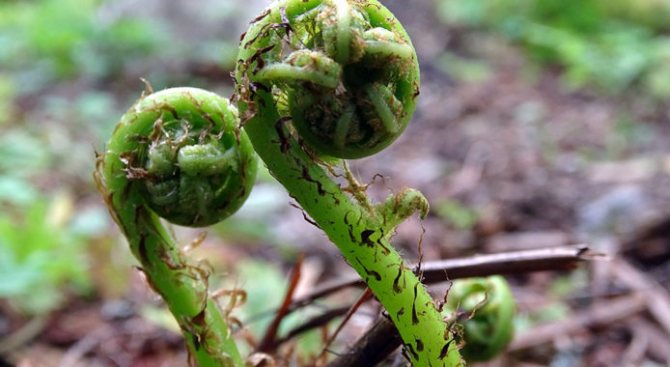

To harden the seedlings, the container lid is first opened slightly, and finally removed when the seedlings get stronger. It is impossible to open the container immediately - with a sharp change in conditions, the sprouts may die. A young fern develops at home for about two years, then it is planted on the site.
Outdoor planting
The flower prefers acidic, moisture-consuming soil
... It will feel great in a deep, or openwork shade. Although of all the species of this plant, it is the ostrich that suffers less from the sun's rays than others.
Due to similar soil requirements, violets, lupins, lilies of the valley can be partners of the ostrich in a shady corner. The flowers will look spectacular and grow comfortably under the viburnum bush. Hosts and lilies get along well with him.
Planting or replanting a flower, preferably in early spring
, until the feather is completely unblocked.
When buying, choose specimens with a strong root system. When separating a young rosette from the mother bush, try to preserve the rhizomes as much as possible. The older this perennial, the larger and higher its nest.
.
If the purchased copy is planted, it is advisable to cut off all the leaves before planting, leaving 1 - 2 strong shoots.
The planting hole should be slightly larger than the root ball, we pour garden compost at the bottom and add (not a lot!) Nitrogenous fertilizers.
Place the plant so that the fern nest is on the surface of the earth
, the deepening can significantly harm the plant.
We fill the hole with garden soil, water it well. When the water is absorbed, mulch the surface with a mixture of garden soil and peat.
Planting a fern in the garden, reproduction:
Care and cultivation features
The flower is completely picky. The first time, while the plants are rooting, seedlings will need watering 1 - 2 times a week
.
Be guided by the weather and the state of the topsoil. In the future, their colony can grow independently, without much care.
Over time, daughter outlets are formed, which can be separated and then transplanted to a new location.
It will be possible to divide and plant ferns throughout the summer, the main thing is to choose cool days for this. It is advisable to transplant this species quickly, not allowing the rhizomes to dry out.
In dry summer, you need to water the plant
, it responds well to evening sprinkling. But if at this moment you are simply absent from the country, adult plants will do just fine without watering.
No special additional care is required.
Growing an ostrich:
It reproduces vegetatively and with the help of spores. For vegetative propagation, segments of creeping rhizomes 20–25 cm long with two buds are used. You can transplant and divide ferns in early spring, before the frond (leaves) regrowth, or in the first half of August, during the ripening of the spores. Some species are successfully propagated by brood buds, which are formed on the convex side on a thickened leaf petiole (frond). The formation of brood buds increases when the central point of growth of the rhizome is disturbed. An adult plant can develop up to 10 buds in a season. In this case, in early spring, the rhizomes are dug up, the petioles with buds are carefully separated. Growing up is carried out in cold greenhouses, with shading. With vegetative propagation, the percentage of planting material yield is low.
It is more efficient to grow ferns from spores, which are formed in large numbers and remain viable for many years. Spores are sown in bowls with disinfected litter peat, covered with glass and regularly moistened. After 2–5 weeks, the spores germinate and the entire surface of the substrate is covered with emerald green fern sprouts. Grown young plants are dived at least twice into boxes with a mixture of equal parts of peat crumbs, heather earth and sand, they are planted in pots for growing and after two years they are planted in place. Ferns grown from spores develop more vigorous and resistant plants.
Household plant
The fern not only adorns the front gardens, but is also a fairly valuable plant in the household. It is not surprising for many, but the ostrich can be eaten. In some areas of America, it is the ostrich that is the main dish of the Indians. Only young vegetative shoots (rachis), which are up to 20 centimeters long, are used for food. It is not recommended to oblige everything at once, otherwise the fern will greatly weaken, and it may disappear, especially a young plant. It is better to collect from an old plant, from a young one take no more than half, then the fern will recover.
If the rakhis breaks without crunching, breaks, then it is no longer possible to eat it, it is overripe. From the moment the rakhis was ripped off, no more than 4 hours should pass. Afterwards, it will become rough and unusable.


You cannot eat raw rachis, it is very bitter. It can be boiled or salted. The plant tastes like cauliflower, slightly sweetish.
When the rachis has been boiled, it is allowed to cool slightly, and so that the glass is unnecessary liquid. Further, it can be fried in a skillet like ordinary mushrooms.
Also, the ostrich can be salted, or rolled up in jars like cucumbers in brine.
At the present time, few people eat fern, it often serves as an adornment of the site. Its chic look allows you to make any interior unique.At the same time, the plant does not require special care.
The ostrich has a tendency to grow rapidly, and therefore thickets are formed. Very often, it is the ostriches that are planted near water bodies. Plus, the plant is very friendly and any flowers in its neighborhood will grow beautifully and create a unique look for your yard.
Reproduction by dividing the bush
An adult plant is chosen for division. In early spring or at the end of August, when the process of sporulation is underway, the bush is dug in, stepping back from the middle of 30-40 cm, and taken out of the ground. The division is carried out so that the length of the rhizome on the divide is 20-30 cm, and the process has at least 2 renewal buds.
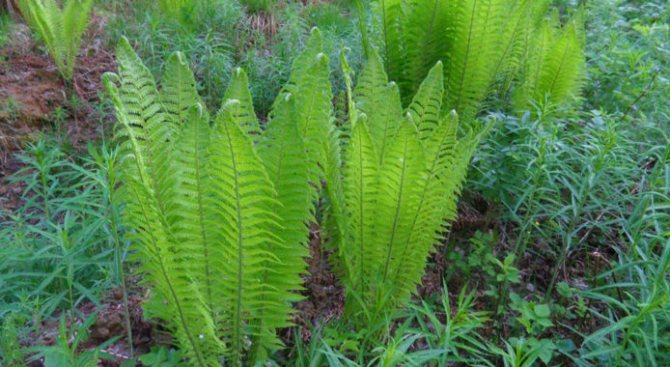

Delenki are planted according to the scheme. If the planting is group, then a distance of 40-80 cm is left between them; when composing a composition with other plants, the indentation length should be at least 50 cm, since the ferns grow and will oppress the neighbors.
Fern species
Do not count all the types of fern, which sometimes differ very much both in appearance and in preferred conditions. I will mention a few.
Common ostrich
Common ostrich
also called “ostrich feather”, as its feathery leaves, reaching 1.5 m in height, resemble the openwork lattice of ostrich feathers.
In spring, the leaves of the ostrich are wrapped in a kind of cocoon, and with the onset of warm days they fluff up and form a luxurious funnel.
The root system is located vertically, so the ostrich needs periodically has strongly dissected leaves, collected in bunches. The size varies from 30 to 70 cm, depending on the variety.
Female kochedyzhnik (Athyrium filix-femina)
The rhizome is short and thick, and the spore-bearing "containers" are covered with a beautiful velvet cover. The female kochedyzhnik is a long-liver; he is able to live in one place without a transplant for more than 10 years.
Nippon kochedyzhnik
Nippon Cochiner (Athyrium niponicum)
notable for the shade of the leaves - silvery-gray, with reddish veins. He prefers shade, but in order for his veins to appear brighter, he needs at least a little sun - better than morning. Propagated by root suckers. When propagated by spores, varietal characteristics are not preserved.
Nippon kochedzhnik "Piktum"
Many types of fern have medicinal properties, and some can be used to make delicious meals. To do this, use young shoots of fern - rachis, after boiling them for 10-15 minutes. What delicious fern dishes do you cook?
The ostrich is a type of fern that can often be found in garden plots. The plant reproduces vegetatively due to scaly creeping shoots.
The fern has two types of leaves:
- sterile:
reach a length of one and a half to two meters, form a pinnate funnel; - spore-bearing:
two or three small leaves inside the funnel.
The name of the plant is due to the similarity of leaves with ostrich feathers. In fact, the plant has a lot of names, among others - German Ostrich.
Large foliage disappears in autumn, only spore-bearing shoots remain for wintering. In spring, their edges open, spores that have got into the soil begin to germinate.
The first leaves appear in May, as soon as stable warm weather sets in. They are folded inward first. Summer frosts can kill shoots, but the plant recovers quickly.
As it grows, young foliage straightens out and forms a large funnel in the middle of summer. Sporiferous leaves appear in August. These brown shoots look very unusual and are often used as dried flowers for flower arrangements.
Differences from other ferns
In appearance, all ostriches look like kochedzhniks or shititniks. However, they have a denser and more massive vegetation. In addition, they differ in the shape of the bush itself. The branches of the ostrich are at the top of the bulbous rhizome in a circle.Its shoots grow at the same time, for this reason, in the summer, the culture resembles a kind of vase.
The ostrich spores are very similar to the feathers of the Emu ostrich. They are formed in the central part of the funnel and reach a size of 55 cm. Inside the sporos there are twisted lobules, similar to miniature "sausages".
Disease prevention
With high humidity or excessive thickening of the plantings, the ostrich may be susceptible to fungal diseases
.
To avoid this, it is enough to mulch the ground under them, do not overuse sprinkling.
The decorativeness of the fern is difficult to overestimate - it is appropriate in any landscape style
... It goes well with aquatic plants near artificial reservoirs and streams.
Can complement a landscape garden, Scandinavian, or Japanese compositions with boulders and slides. Even a regular garden may well combine ferns with other flowering plants, here the graphic clarity of the ostrich is useful
.
The decorative style of the fern is simply the embodiment of tranquility and solitude.
Distinctive features
Ferns of the genus Ostrich (Matteuccia) are found near water bodies, under the canopy of a moist mixed forest, in ravines in Central Europe, Siberia and the Far East. Outwardly, they are similar to other ferns, but they have several characteristic features by which they can be distinguished.
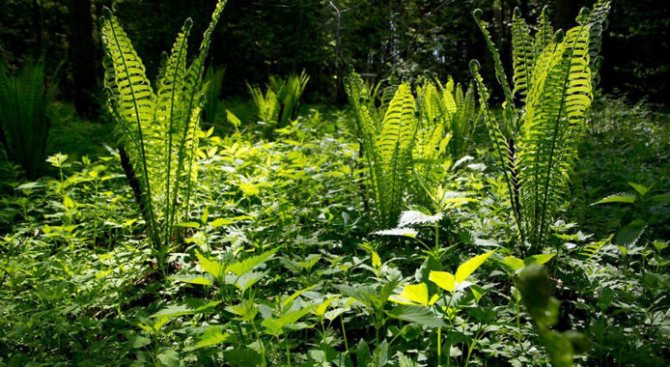

The genus got its name because of the similarity of the frond (leaf-like organ) with the feather of an ostrich. Sometimes called a raven wing, ostrich feather, ostrich feather. Hebrew, bedbug, river fern, black grass in the people nicknamed him because of its inherent features - drives away bedbugs, grows near rivers and streams.
In the spring, shoots grow from a thick, vertically located rhizome, which are called vayami. At first they are rolled up like a snail's shell, but gradually they straighten out, reaching 20-30 cm in width, and grow in length by 150 cm or more. The color of the feathery shoots is rich green, they actively undergo the process of photosynthesis. Their arrangement is typical for the species - in a circle around the rhizome, therefore the shape of the bush, with a diameter of 1-2 m, resembles a vase expanding upward.
By the end of summer, new green dense fronds with folded leaves appear in the center of the funnel from pinnately dissected shoots. Their length is much shorter than the outer ones (50-60 cm), they seem to be inside the vase. These are spore-bearing fronds that do not grow in the first year of life, but several years later.
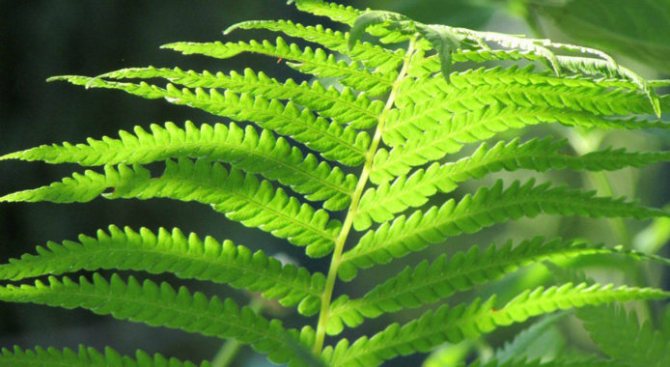

As they grow, they darken, from green to dark brown. The color change indicates that the maturation of the spores has begun.
In everyday life, fronds are called leaves, but in fact they are shoots, because their growth zone is on top, and the leaf grows from below - the cells divide there. Ferns grow at the top.
Green fronds are sterile; spore formation occurs on dark ones in the inner side of the sporangia. External shoots die off in autumn, and dark ones hibernate along with spores and can persist for more than one year. In the spring, the leaf will unfold, giving the opportunity to scatter disputes. In moist soil after winter, germination occurs almost immediately, which distinguishes the ostrich opera from other varieties. Spore-bearing frond looks beautiful in a bouquet.
With age, the old bush develops a pineapple-like stem, the surface of which is covered with thorns that formed on the site of last year's shoots. The presence of a stem is a distinctive feature of the genus.
How to plant correctly
So that the time for growing a fern is not wasted, you need to familiarize yourself with the rules for planting it and the features of further care.
Preparation
The place for the Ostrich is suitable both in dense shade and in a sunny meadow. The main requirement is a sufficient amount of moisture. On the sunny side, the bushes form slightly lower than when placed in the shade.
Before planting, the roots of the seedling must be soaked for 15-20 minutes in a solution of potassium permanganate (low concentration). This is done to disinfect the young shoot. Immediately before transferring the plant to open ground, the pot is lowered with it into a container with water. After the air bubbles come out, the pot is removed and the fern is carefully removed. You do not need to peel the root from the earth.
Reference! The planting area is determined taking into account the minimum distance of the fern to other plants. It is impossible to plant closer than 50 cm of culture.
The root of the fern quickly throws out shoots for reproduction. To prevent thickening of the planting, you should bury the restraints around the entire circumference of the bush. Any auxiliary material is used as a fence: plastic bottles, geotextiles, flexible curbs, etc. It must be deepened to a level of 30 cm below the ground surface.
The Ostrich is picky about soils. The plant grows on fertile and poor soils, prefers a slightly acidic or neutral environment. But sandy soil for a plant is not the best choice. On such a site, an automatic irrigation system is built, or the soil layer is replaced with a nutritious soil mixture of black soil, peat and humus.
Planting instructions
For planting on the site, seedlings are selected that have reached 2-3 years of age. If a voluminous composition is being built, it is worth choosing at least 5-7 shoots. However, it should be borne in mind that the plant multiplies rapidly. An interval of 30 to 100 cm should be left between the bushes.
Designers use different forms of fern planting. An irregular triangle is considered the most attractive.
In a prepared place, a seedling is transferred to a moistened hole, the root is straightened and covered with prepared soil mixture. Florists recommend using nutritious soil so that the plant quickly adapts to new conditions.
Planting ends with irrigation. For irrigation, you need to take settled water with a temperature in the range of 17 ° - 22 °.
When growing a fern indoors (in a pot), you can plan planting at any time of the year.
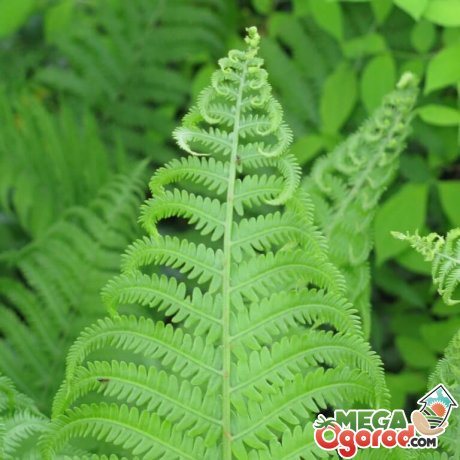

Ostrich harvesting:
Rhizomes, fronds (leaves) and spores are harvested as medicinal raw materials. Rhizomes are dug up in the fall, washed from the ground, removed small adventitious roots, cut lengthwise so that the petioles of last year's leaves do not crumble, and dried in the wind, under awnings or in attics, after drying in the sun. Leaves are harvested mainly spore-bearing, in July - August. They are laid out in a thin layer on thick paper or hung over it so that sporangia can then be collected from the sporangia that open during drying. The scattered spores are sifted through fine sieves, freeing from impurities.
How to buy ostrich fern seedlings in our nursery
You can buy one Fern plant from 150 rubles. We send plants and flowers to nonresident customers by mail.
A short description, as well as other photos of the fern taken in our nursery in different periods of growth of this plant, you can see here: Fern Ostrich.
Description and recommendations for growing other plants:
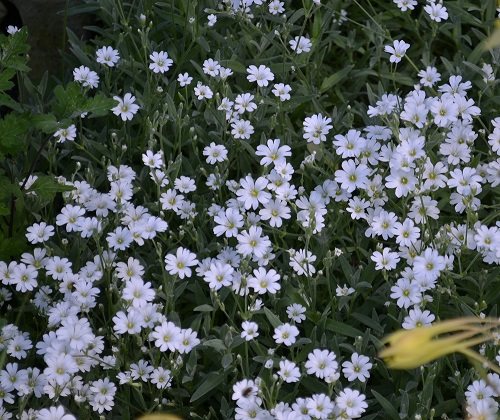

Yaskolka - description, planting and care
Planting, cultivation and reproduction of chickens. Recommendations for the care of the chowder for beginner gardeners.


Matricaria: description, planting and growing
A detailed description of the annual plant matricaria maiden. Recommendations for planting the matrix in open ground.
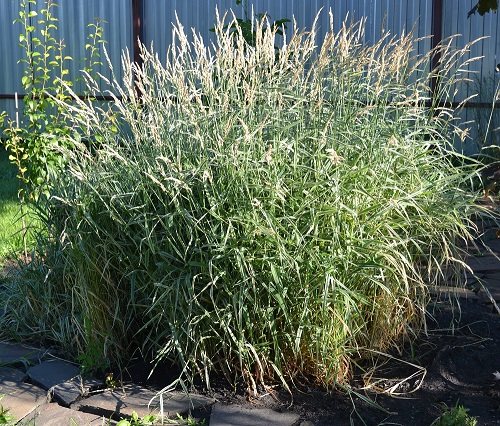

Two-source reed (falaris) - description
A detailed description of the perennial herbaceous plant falaris or two-source reed (sedge). Recommendations for planting, cultivation and care.
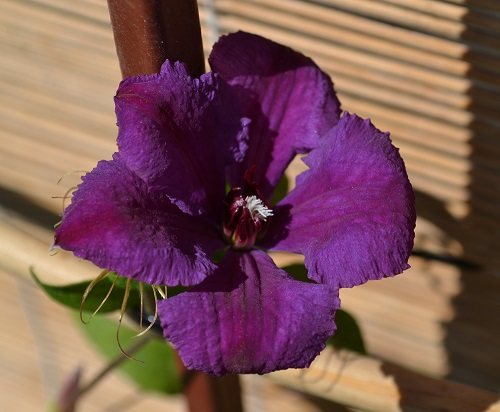

Clematis - planting and care
Description of the most popular types of clematis. Recommendations of an experienced gardener for planting, growing and caring for clematis.
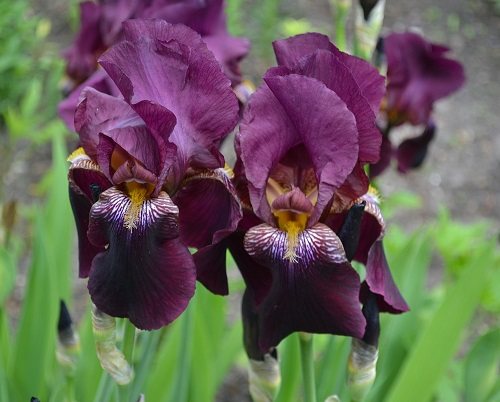

Iris bearded hybrid - description
Hybrid bearded iris can be bought in our nursery with a closed root system, in a pot with soil.
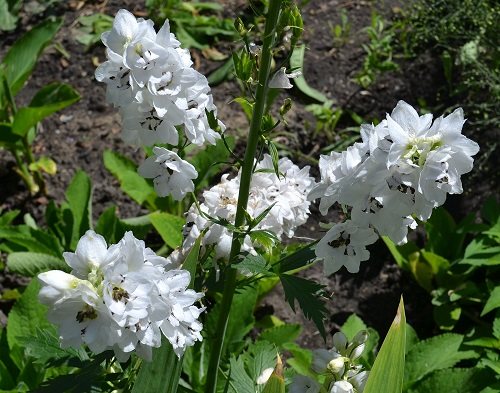

Delphinium - description and cultivation
Recommendations and advice on growing delphinium, proper care for it and methods of reproduction.
Fern planting
All fern species love shaded areas and moist soils. If you have shaded areas in your dacha where other plants feel uncomfortable, plant a fern there, it easily tolerates conditions unfavorable for other plants and poorly fertilized soils.
When planting a fern, use common sense: the distances between the planting holes and the depth of the holes are based on the size of the plant in adulthood. When planting long-rooted fern species, either assign them large areas (as they can greatly pressurize their "neighbors"), or make an artificial limitation of the area for them.
Fern propagation by spores
Fern is an asexual plant that does not have flowers and reproduces in nature disputes
... On the lower part of the leaf of an adult plant, small tubercles are visible - these are the "containers" with spores.
For fern propagation by spores:
- In autumn, the "containers" are cut off together with a part of the sheet and placed in paper bags for drying.
- At the end of January, spores are sown in boxes with a soil substrate: peat (2 parts), leaf earth (1 part), sand (1 part). Fern spores are a fine powder, which is poured onto the soil surface in a thin layer without sprinkling it with earth, then moistened from a spray bottle, the boxes are covered with glass and placed in a warm room.
- Disputes usually germinate in the 2nd month after sowing, then the glass should be removed in order to provide the "kids" with air flow. During this period, the embryos look like a thin layer of moss.
- But when the closure of several specimens into single plants appears in the "moss", then they should be planted in separate pots 7-8 cm high and 10-12 cm in diameter.
This way, by spring, you will have fern seedlings ready to be planted outdoors.
Fern propagation by dividing the bush
Long-rooted ferns (,) are easier to propagate dividing the bush
rather than disputes. The division of the bush is usually done in early spring, after the end of spring.
Fern propagation by rhizome mustache
Some fern species (nephrolepis sublime and cordifolia) have aboveground rhizome whiskers, from which young shoots grow.
The mustache should be dug into the soil to a depth of 8-12 cm and thoroughly spill the earth with water.
Fern propagation by brood buds
On the leaves of some species of ferns (kostenets, mnogoryadnik) are formed brood buds
from which young plants ("babies") subsequently develop.
"Children" should be separated from the leaf, placed on a damp peat moss surface, covered with a glass jar and the seedlings should be placed in a warm, shaded place in the house. "Children" quickly take root, and after 2-3 weeks they can be safely planted in open ground.

